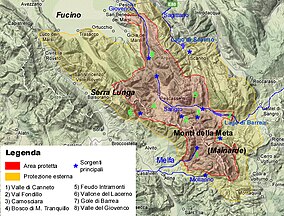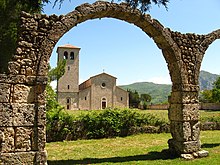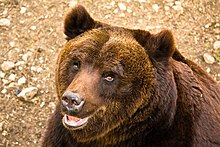Abruzzo, Lazio and Molise National Park
| Abruzzo, Lazio and Molise National Park | |
|---|---|
| Parco Nazionale d'Abruzzo, Lazio e Molise | |
 | |
 | |
| Location | Abruzzo, Lazio, Molise |
| Nearest city | Rome |
| Area | 496.80 km2 (191.82 sq mi) |
| Established | 1923 |
| Governing body | Ministero dell'Ambiente |
| www | |
Abruzzo, Lazio and Molise National Park (Italian: Parco Nazionale d'Abruzzo, Lazio e Molise) is an Italian national park established in 1923. The majority of the park is located in the Abruzzo region, with smaller parts in Lazio and Molise. It is sometimes called by its former name Abruzzo National Park. The park headquarters are in Pescasseroli in the Province of L'Aquila. The park's area is 496.80 km2 (191.82 sq mi).[1]
It is the oldest in the
History

The idea for the Abruzzo National Park arose in the years following World War I thanks to the work of Erminio Sipari, environmentalist, member of Italian Parliament and cousin of Benedetto Croce.[2] Between the months of October and November 1921, the municipality of Opi leased 5 square kilometres of land to a private federation with the aim of protecting flora and fauna and Sipari founded in Rome an organization to administer the reserve.[3] So the Park was founded in September 1922.[4] Over the next few years the territory of the park expanded into neighbouring municipalities until it covered around 120 km2 by 1923, when protection was enshrined in law. A period of intense activity followed and the park had further expanded to around 300 km2 when it was abolished by the Fascist government in 1933.

Re-establishment of the park in 1950 coincided with a period of financial difficulty, followed by a building boom which saw more than 12,000 trees felled for the construction of houses, roads and ski tracks. A reorganization of the park management at the end of the 1960s heralded better times and by 1976 further expansion, to 400 km2, followed at the request of villages in neighboring Molise, that were convinced by the economic benefits of the park. Today, at 500 km2, the area of the park is 100 times larger than the original reserve. However the park's role in the marsican bear conservation program is now strongly debated; while every year there are monitoring actions of the total bear's population there have been recently some problems related to the pave actions carried out inside the park's boundaries and the building projects to connect the only ski track of the park to the opposite valley, which is a delicate spot for the bear's movements.
Geography
The mountains within the park are Petroso (2,249 metres),
Fauna



In wildlife terms, the main attractions of the park are the Marsican brown bear and Italian wolf. While official figures report 50-70 bears in this genetically isolated population, the declining population is actually estimated at closer to 30.[6] The shift from local agriculture to development in Abruzzo (including a controversial proposed ski resort) and poaching, threaten this remaining small population.[7] While Wolves were once rarer (as low as 40), numbers have reportedly rebounded in recent years.[8]
The presence of the Eurasian lynx in the park is still controversial, and there are no scientific studies that prove it; however, there are some unconfirmed sightings.[citation needed]
In greater numbers, in the thicker areas of the forest, are
Animals that are easier to see include
]Birds
Many birds of prey inhabit the park. Most notable amongst them is the
Plants
The flora of the park is rich and interesting. A comprehensive list of plants would extend to more than 2,000 species without including
The predominant tree of the park is the
Municipalities
The park covers 25 municipalities, distributed across 3 provinces.[5]
Province of L'Aquila:
- Alfedena, Barrea, Bisegna, Civitella Alfedena, Gioia dei Marsi, Lecce nei Marsi, Opi, Ortona dei Marsi, Pescasseroli, Scanno, Villavallelonga, Villetta Barrea
Province of Frosinone:
- Alvito, Campoli Appennino, Pescosolido, Picinisco, San Biagio Saracinisco, San Donato Val di Comino, Settefrati, Vallerotonda
Provincia of Isernia:
- Pizzone, Rocchetta a Volturno, Scapoli
Activities
Many outdoor activities are possible within the park including,
- Horse riding
- Trekking
- Cycling
- Canoeing
- Bird watching
- Alpine skiing
- Cross-country skiing
See also
References
- ^ "Parco Nazionale d'Abruzzo, Lazio e Molise". parks.it. 2004–2010..
- Peter Lang (publishing company), Bern 2000, pp. 165-181; Marco Armiero - Marcus Hall (ed.), Nature and History in Modern Italy, Ohio University2010
- ^ "Parco Nazionale d'Abruzzo, Lazio e Molise". parcoabruzzo.it. 2011.
- ^ Lorenzo Arnone Sipari, Il Parco Nazionale d'Abruzzo liberato dall'allagamento. Un conflitto tra tutela ambientale e sviluppo indutriale durante il fascismo, "Rivista della Scuola Superiore dell'Economia e Finanza", 2003, nr. 8-9: 27-39 Archived 2012-04-25 at the Wayback Machine; Lorenzo Arnone Sipari (ed.), Scritti scelti di Erminio Sipari sul Parco Nazionale d'Abruzzo (1922-1933), Trento 2011.
- ^ a b "The National Park of Abruzzo, Lazio e Molise". NAP - Network of Adriatic Parks. Archived from the original on 2009-04-10.
- ISBN 978-1-905847-14-3.[page needed]
- ^ Hooper, John (21 August 2004). "Italy battles to save the last of its wild bears". The Guardian.
- ^ "Wolves at Florence's gates". Italy Magazine. 13 June 2007.
- ^ "The Abruzzo National Park". opionline.it. Retrieved 28 October 2015.
External links
- "Official website" (in Italian).
- "Italy - Abruzzo, Lazio and Molise National Park". Wild Zone.[permanent dead link]
- Fletcher, Adrian (2000–2010). "Parco Nazionale d'Abruzzo". paradoxplace.com. Archived from the original on 2010-04-14.


